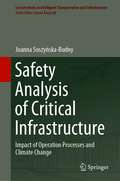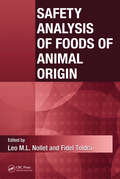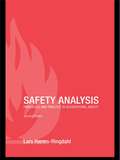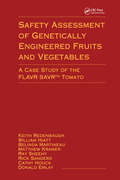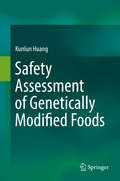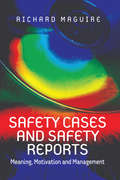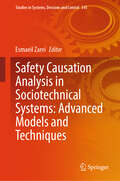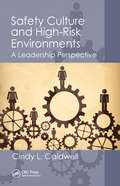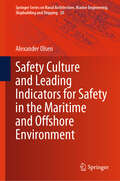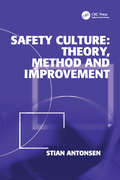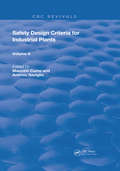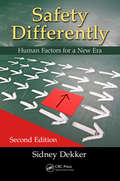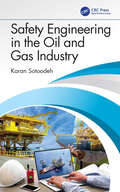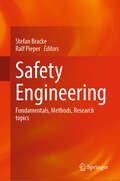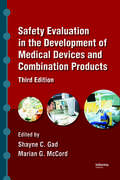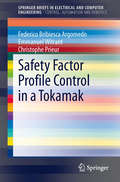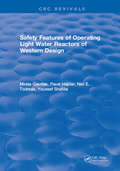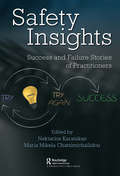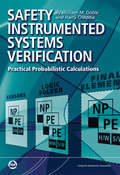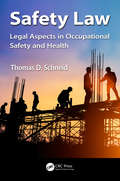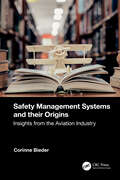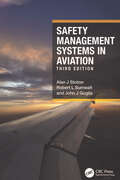- Table View
- List View
Safety Analysis of Critical Infrastructure: Impact of Operation Processes and Climate Change (Lecture Notes in Intelligent Transportation and Infrastructure)
by Joanna Soszyńska-BudnyThis book deals with critical infrastructure safety analysis based on reliability modelling of multistate ageing system. It shows how changes of the operation process as well as climate-weather changes in the operating area of the critical infrastructure do influence the safety parameters of its assets. Building upon previous authors’ research, the book formulates an integrated modeling approach where the multistate critical infrastructure safety model is combined with semi-Markov models for its operation process and for the climate-weather change process. This approach is shown to be successful in determining basic critical infrastructure safety, risk and resilience indicators, regardless of the number of assets and the number of their safety states. Besides the theory, the book reports on a successful application to the safety analysis of a real critical infrastructure, such as a port oil terminal. All in all, this book proposes a comprehensive and timely review of cutting-edge mathematical methods for safety identification, prediction and evaluation of critical infrastructures. It demonstrates that these methods can be applied in practice for analyzing safety of critical infrastructure under time-varying operation and climate-weather change processes.
Safety Analysis of Foods of Animal Origin
by Fidel Toldrá Leo M.L. NolletWe cannot control how every chef, packer, and food handler might safeguard or compromise the purity of our food, but thanks to the tools developed through physics and nanotech and the scientific rigor of modern chemistry, food industry and government safety regulators should never need to plead ignorance when it comes to safety assurance. Compiled
Safety Analysis: Principles and Practice in Occupational Safety
by Lars Harms-RingdahlSafety analysis can be applied as a practical tool in occupational safety. It has three main elements: the identification of hazards, the assessment of risks that arise, and the generation of measures to increase the level of safety. A number of simple methods are described that can be used in industry and the workplace, such as deviation analysis,
Safety Assessment of Genetically Engineered Fruits and Vegetables: A Case Study of the Flavr Savr Tomato
by Keith RedenbaughUse of genetically engineered plants for food production has raised many questions about food safety. Scientists, environmentalists, and government regulators have debated safety issues since the advent of genetic engineering.
Safety Assessment of Genetically Modified Foods
by Kunlun HuangThis book introduces readers to food safety assessment research on Genetically Modified Organisms (GMOs). As is broadly known, the main concerns about GM foods' adverse effects on health are the nutrients, toxicity, allergenicity and unexpected effects. Before GMOs can be made commercially available, a comprehensive food safety assessment - taking these concerns into account - must first be performed. Exploring these aspects, the book is divided into two parts: the first part focuses on the safety assessment guidelines of the CAC, while the second highlights new methods used for the evaluation of GMOs' safety. Offering an essential, practical guide, it will be of interest to researchers and graduate students in the fields of food science and public health.
Safety Cases and Safety Reports: Meaning, Motivation and Management
by Richard MaguireThe safety case and its associated reports are quickly becoming not only a mechanism for achieving safety goals, but also a valuable decision-support asset, and a vital industrial liability management tool. Recent developments in industry have led to safety cases being frequently required as contractual deliverables as part of large and complex commercial programmes. A safety case consists of a rational argument and detailed evidence to justify and demonstrate that a system or product is tolerably safe in its use, and that it has a management programme to ensure that this remains so. The safety case report is the snap-shot presentation of the arguments and evidence demonstrating the contemporary safety performance of the system and the programme that is in place. This book, written from personal experience and reference, provides a concentrated source document for assessing and constructing safety cases and safety case reports - from understanding their purposes, through their development and on to their presentation.
Safety Causation Analysis in Sociotechnical Systems: Advanced Models and Techniques (Studies in Systems, Decision and Control #541)
by Esmaeil ZareiThis book provides a comprehensive view on theories, models, and techniques used to investigate and analyze incidents and safety causalities occurring in sociotechnical systems. Consisted of intricately interconnected components, sociotechnical systems are always prone to incidents. These incidents can ensue with adverse effects on employees and the public, the environment, and company's properties and reputation. Sometimes, a single incident has the potential to terminate the operation of a business forever. As incidents are multi-factorial and not easy to comprehend, they should be investigated systematically in a structured way so as to find their root causes and prevent them from recurring. Consequently, there have been developed many theories, models, and techniques aimed at accomplishing this goal. However, each approach has its own upsides and downsides, and there is no universal one applicable to all cases. Therefore, researchers and practitioners may sometimes find it difficult to select the most appropriate approach for the given case. After introducing theories, models, and techniques pertaining to incident investigation and safety causalities modeling, this book explains each one in details and discusses their pros and cons. The book aims to provide the audience with a step-by-step guidance for performing incident investigation and analysis. At the end of each chapter an example is analyzed by the introduced tool. Finally, the book offers criteria based on which an incident analysis technique can be selected.
Safety Culture and High-Risk Environments: A Leadership Perspective (Sustainable Improvements in Environment Safety and Health)
by Cindy L. CaldwellThis book provides leaders in high risk industries a better understanding of how their values and behaviors can influence the organization's safety culture and improve its capacity to bounce back from failure. Examples are illustrated through case studies and practical tools are provided to evaluate and improve an organization's culture by improving leadership capability. This unique book integrates the areas of safety culture and high reliability from the perspective of leadership in a work team environment. Readers of the book will get a fresh perspective on safety culture and reliability that can be translated into practical steps for improving their organization through its leadership.
Safety Culture and Leading Indicators for Safety in the Maritime and Offshore Environment (Springer Series on Naval Architecture, Marine Engineering, Shipbuilding and Shipping #20)
by Alexander OlsenThis book provides guidance and insight into the development process for safety indicators to comply with general classification rule requirements. The utilisation of this guidance will provide tangible benefits as the marine and offshore industry is able to realise the positive results of tangible safety indicators that are developed correctly and managed appropriately throughout the lifecycle of the vessel or platform. In the marine and offshore industry, design and equipment configurations vary from one system to the next, and systems are in many cases increasingly complex. There are gaps in codes and standards which may lag technological innovations and there are issues related to interfaces between systems. Safety indictors such as risk analyses, FMEA, job safety analyses, management of change procedures, HSQE, technical manuals and reliability-based maintenance provide a formalised approach to identify hazardous situations, address the gaps and interconnection variances, and improve safety, environmental performance and operational downtime. The majority of Classification Societies (‘Class’) require their clients to develop and submit safety indicators as part of the classification requirements for certain systems and to obtain certain special notations.
Safety Culture: Theory Method And Improvement
by Stian AntonsenThe aim of this book is to show how a cultural approach can contribute to the assessment, description and improvement of safety conditions in organizations. The relationship between organizational culture and safety, epitomized through the concept of 'safety culture', has undoubtedly become one of the hottest topics of both safety research and practical efforts to improve safety. By combining a general framework and five research projects, the author explores and further develops the theoretical, methodological and practical basis of the study of safety culture. What are the theoretical foundations of a cultural approach to safety? How can the relationship between organizational culture and safety be empirically investigated? What are the links between organizational culture and safety in actual organizations? How can a cultural approach contribute to the improvement of safety? These are the key questions the book seeks to answer with a unified and in-depth account of the concept of safety culture.
Safety Design Criteria for Industrial Plants: Volume 2 (Routledge Revivals)
by Maurizio Cumo Antonio NaviglioFirst published in 1989: A generalization and rationalization of the main safety design criteria and safety analysis methodologies developed in nuclear aerospace and chemical engineering is presented in two comprehensive volumes. The concepts of risk, damage and probability of hazardous events are introduced. Risks connected with the use of main harmful substances are quantitatively identified. The methods employed for the safety analyses are described, together with the methodologies for seismic analyses and for Probabilistic Risk Assessment. The main criteria for protection of plants from internal and external events are introduced and described. In addition, the problem of emergency planning is considered. This book is particularly intended for engineers working in the nuclear field, in chemical industries, in industrial plants, in fuel storages and with high-risk substances, as well as for engineers operating in licensing organizations and for inspectors.
Safety Differently: Human Factors for a New Era, Second Edition
by Sidney DekkerThe second edition of a bestseller, Safety Differently: Human Factors for a New Era is a complete update of Ten Questions About Human Error: A New View of Human Factors and System Safety. Today, the unrelenting pace of technology change and growth of complexity calls for a different kind of safety thinking. Automation and new technologies have resu
Safety Dynamics: Evaluating Risk in Complex Industrial Systems (Advanced Sciences and Technologies for Security Applications)
by Emmanuel Garbolino Franck GuarnieriThis book describes a systematic approach to risk assessment for complex socio-technical systems like industrial processes, especially innovative ones. It provides an overview of applications of system dynamics theory and methodologies on industrial systems in order to demonstrate the relevance of such an approach in helping to assess risks in such complex systems. An important feature of this approach is that it takes into account the dynamic of the interactions of the components (technical, human and organizational ones) in order to study and simulate the behavior of the system. This methodology helps to define the failures and/or accident scenarios and to implement and test the prevention and protection barriers. This book is of particular interest to students and teachers at university level (Master and Doctorate) and to engineers interested in risk analysis and management.
Safety Engineering in the Oil and Gas Industry
by Karan SotoodehWhen accidents occur in the oil and gas industry, the impacts can be profound. Serious injury or death to workers, environmental disasters and colossal costs for insurance or clean ups make the industry a hazardous one to operate in. Disasters become major news events such as the Prestige oil spill, Piper Alpha, Exxon Valdez oil spill and Deepwater Horizon. A move towards improving the health and safety of the industry is underway. This book emphasizes controlling, managing, and mitigating the risk of hazards in the oil and gas industry, increasing safety, and protecting the environment by identifying the hazards in the oil and gas industry through safety engineering techniques and management methods. Safety Engineering in the Oil and Gas Industry discusses how to improve safety and reliability in the oil and gas industry so that hazards can be reduced to the lowest level feasible. It covers the techniques needed to operate safely in an oil and/or gas industry setting, the standards that should be adhered to, the impacts of PPE, fire and explosions, equipment and infrastructure failures and storage and reliability engineering, amongst many other topics. This book is written in an easy-to-read and appealing style and multiple-choice questions are included to help with learning and understanding the concepts included. Underpinned by real life case studies and examples, this book aims to allow readers to consider how they can reduce the costs associated with bad safety practices to their business through maintained and consistent health, safety and environmental (HSE) standards. This book is a must-read for any student or professional studying or working in the oil and gas industries. It also has additional appeal to those with an academic or professional interest in occupational health and safety, civil engineering, offshore engineering and maritime engineering.
Safety Engineering: Fundamentals, Methods, Research topics
by Stefan Bracke Ralf PieperSafety engineering is an engineering discipline with an interdisciplinary and application-oriented focus. The main focus is on the knowledge-based development and application of methods for the analysis and prevention of hazards and the minimization of remaining hazards to human safety and health and to the environment, particularly in connection with technically complex products, systems and processes. At the University of Wuppertal, Germany, safety engineering has been an established teaching and research area for 50 years. It covers a wide area of subjects from e. g. plant and product safety over energy efficiency to safety and quality law. This book provides an overview of the fundamentals, methods and current research results as well as examples of the application of teaching and research activities in safety engineering at the University of Wuppertal. The target groups are therefore equally engineers, scientists and engineering students who deal with questions of safety engineering in an application-oriented and scientific context.
Safety Ethics: Cases from Aviation, Healthcare and Occupational and Environmental Health
by Manoj S. PatankarMuch of the previous literature in the field of safety focuses on either the technical equipment issues or the human performance factors that contribute to the active failures in safety-critical systems. However, this book provides guidance in the moral or ethical aspects of decision-making that perpetuate many of the latent failures in safety-critical systems. The book provides a concise introduction to the ethical foundations and follows up with case studies from aviation, healthcare, and environmental and occupational health.
Safety Evaluation in the Development of Medical Devices and Combination Products
by Shayne C. Gad Marian G. McCordCapturing the growth of the global medical device market in recent years, this practical new guide is essential for all who are responsible for ensuring safety in the use and manufacture of medical devices. It has been extensively updated to reflect significant advances, incorporating combination products and helpful case examples of current real-l
Safety Factor Profile Control in a Tokamak
by Federico Bribiesca Argomedo Emmanuel Witrant Christophe PrieurControl of the Safety Factor Profile in a Tokamak uses Lyapunov techniques to address a challenging problem for which even the simplest physically relevant models are represented by nonlinear, time-dependent, partial differential equations (PDEs). This is because of the spatiotemporal dynamics of transport phenomena (magnetic flux, heat, densities, etc. ) in the anisotropic plasma medium. Robustness considerations are ubiquitous in the analysis and control design since direct measurements on the magnetic flux are impossible (its estimation relies on virtual sensors) and large uncertainties remain in the coupling between the plasma particles and the radio-frequency waves (distributed inputs). The Brief begins with a presentation of the reference dynamical model and continues by developing a Lyapunov function for the discretized system (in a polytopic linear-parameter-varying formulation). The limitations of this finite-dimensional approach motivate new developments in the infinite-dimensional framework. The text then tackles the construction of an input-to-state-stability Lyapunov function for the infinite-dimensional system that handles the medium anisotropy and provides a common basis for analytical robustness results. This function is used as a control-Lyapunov function and allows the amplitude and nonlinear shape constraints in the control action to be dealt with. Finally, the Brief addresses important application- and implementation-specific concerns. In particular, the coupling of the PDE and the finite-dimensional subsystem representing the evolution of the boundary condition (magnetic coils) and the introduction of profile-reconstruction delays in the control loop (induced by solving a 2-D inverse problem for computing the magnetic flux) is analyzed. Simulation results are presented for various operation scenarios on Tore Supra (simulated with METIS) and on TCV (simulated with RAPTOR). Control of the Safety Factor Profile in a Tokamak will be of interest to both academic and industrially-based researchers interested in nuclear energy and plasma-containment control systems, and graduate students in nuclear and control engineering.
Safety Features of Operating Light Water Reactors of Western Design
by M. GavrilasThis text arose from a study originally undertaken for the Department of Energy to characterize the principal safety features of light water reactors of western design. This text should be of use to professional engineers interested in safety assessment of operating light water reactors, students interested in the principal safety features of LWRs, and others interested in tracing the design evolution of light water reactors. However, while ambitious in its scope, this text should not be viewed as presenting the levels of reactor safety of the various families of western reactor designs.
Safety Insights: Success and Failure Stories of Practitioners
by Nektarios Karanikas and Maria Mikela ChatzimichailidouPublic safety, as well as the safety of products and services, is of paramount importance and interest to individuals, organisations and society. Safety successes are achieved every second, but we take them for granted and we do not appreciate the challenges professionals meet to make the world as safe as possible. Safety failures are less frequent but become focal points of stakeholders and the public with a tendency to blame and not comprehend the context and the hard decisions professionals have to make when balancing safety with competing goals. This edited book includes case studies from industry practitioners exactly as they experience them without relying on the understanding of researchers who conduct studies and try to map the overall situation per case based on multiple interviews, observations and questionnaires. Included are case studies from the aviation, construction, oil and gas, telecommunications, transportation, health and public safety industries. They are stories told by frontline practitioners who work to keep the public safe. In each chapter, the author, based on his/her professional experience, shares two real cases, one "success" and one "failure", explaining the background and approach, and critically reflecting why his/her initiatives and activities worked or didn’t work. They are descriptive of the case, context and tools, techniques, methods and approaches followed and include the valuable safety lesson learned. This book is a forum for professionals to express and share with others their knowledge and experience usually found implicitly or hidden under formal and informal practices.
Safety Instrumented Systems Verification: Practical Probabilistic Calculations
by William M. Goble Harry CheddieThis book clearly explains how to do probabilistic calculations to accomplish SIL verification for safety systems. Starting with a description of the safety life cycle, the authors show where and how SIL verification fits into the key activities from conceptual design through commissioning. The book not only explains the theory and methods for doing the calculations, the authors also provide many examples from the chemical, petrochemical, power and oil & gas industries. Through numerous examples, the authors make the material understandable, plus the data tables give readers important information needed to do the verification calculations. The authors provide example failure rate data and other important metrics needed for probabilistic calculations. Appendices cover probability, failure modes, diagnostic analysis, fault tree analysis, Markov Models, and system architectures.
Safety Law: Legal Aspects in Occupational Safety and Health (Occupational Safety & Health Guide Series)
by Thomas D. SchneidSafety professionals must prepare every day to safeguard their employees in the workplace. Additionally, part of every safety professional’s responsibility is to safeguard their organization when a compliance inspection is conducted by federal, OSHA, or a state plan agency. Safety professionals are most organizations’ onsite safety and health "expert" and should be prepared far in advance of an inspection. They should be prepared during the inspection, and ready to defend the organization after the inspection. With the increase in the monetary penalties, the impact on an organization as a result of identified violations can be substantial. <P><P>This text prepares and educates safety professionals to address every phase from strategies, to compliance, to defenses, and provides a one stop location for information to address and prepare the safety professional if/when OSHA knocks at the door. Additionally, the safety function does not work in a vacuum. Other potential risks and potential liabilities from other laws, such as the ADA, which can impact the safety function, are also addressed. Safety professionals know that their organizations depend on their experience and expertise in their decision-making process. <li>Provides a legal prospective to prepare safety professionals for OSHA inspection and related potential risks <li>Case studies to enhance learning and state-by-state listing of applicable laws and regulations <li>Demonstrates an understanding of defense preparation and strategies for safety professionals <li>The safety professional’s "go to" book for compliance and inspections
Safety Leadership: A Different, Doable and Directed Approach to Operational Improvements
by Robert J. de BoerAimed at those who are responsible for the overall performance of organisations, divisions or departments in diverse industries such as healthcare, aviation, construction, oil and gas, nuclear, railways and defence, this book introduces a new safety paradigm in comprehensible and practical terms. It aims at improving safety and overall organisational performance through a doable, different and directed approach using multiple small steps. This book will help readers in understanding how to integrate the natural variability of human performance – and our ability to compensate for unpredictability elsewhere – into organisational systems, thereby ensuring successful outcomes. It covers important topics, including complexity, effective workplace innovations, micro-experiments, maintaining alignment between rules and reality, maximising learning and restoring relations. It includes practical examples and supporting material referenced in the expansive notes section. This book: Presents multiple small steps that collectively facilitate the improvement of safety Discusses improving safety in routine work;, not triggered by accidents Covers a chapter on what to do when things go wrong Discusses these methods with the help of numerous vignettes Has a separate section on each industry Safety professionals, academicians, researchers and students (undergraduate and graduate) in health and safety, human factors, ergonomics, occupational health and safety will also appreciate the brevity and clarity of this work in conveying the latest scientific insights on safety.
Safety Management Systems and their Origins: Insights from the Aviation Industry
by Corinne BiederSafety Management Systems and their Origins: Insights from the Aviation Industry presents different perspectives on SMS to better decode what it means as a safety approach and what it implicitly conveys beyond safety. The book uses the aviation industry as a basis for analyzing where the SMS stands in terms of safety enhancement. Through a socio-historical analysis of how SMSs emerged and spread across high-risk industries and countries, the book also explains the other stakes underpinning this new approach to safety management. Features: Explores SMS as it is implemented in aviation based on examples from several countries and regions, namely the UK, USA, and Australia. Presents a socio-historical analysis of how SMSs emerged in high-risk industries. Provides insights to explain the existing limitations of SMS. Proposes new avenues to reach beyond the limitations of SMS. Discusses the COVID-19 pandemic within the framework of risk analysis. The book is intended for safety professionals and regulators, as well as graduate students and researchers in safety science and engineering.
Safety Management Systems in Aviation (Ashgate Studies In Human Factors For Flight Operations Ser.)
by Alan J Stolzer Robert L Sumwalt John J GogliaSafety Management Systems in Aviation presents the quality management underpinnings of SMS. The four components that must be designed into proactive safety are: Safety Policy, Safety Risk Management, Safety Assurance, and Safety Promotion. Including coverage on the cultures of regulatory organizations and expanded coverage on culture assessment, the book considers the nexus between cultural maturity and safety management performance. This third edition features new coverage of international requirements and implications for harmonization across international boundaries. In addition, the book includes new chapters and sections, examples, a hypothetical airline-oriented safety scenario, and case studies to enhance and reinforce student understanding. The book is intended for undergraduate and graduate aviation students taking Safety Management and Aviation Safety courses. It also functions as a valuable reference tool for SMS practitioners.
